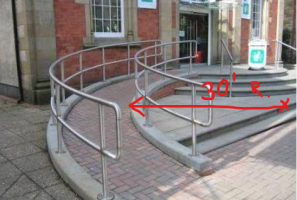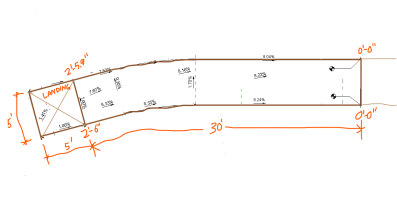-
Welcome to The Building Code Forum
Your premier resource for building code knowledge.
This forum remains free to the public thanks to the generous support of our Sawhorse Members and Corporate Sponsors. Their contributions help keep this community thriving and accessible.
Want enhanced access to expert discussions and exclusive features? Learn more about the benefits here.
Ready to upgrade? Log in and upgrade now.
You are using an out of date browser. It may not display this or other websites correctly.
You should upgrade or use an alternative browser.
You should upgrade or use an alternative browser.
Ramp With Curve
- Thread starter Phil B
- Start date
Dinheru
REGISTERED
Where do you measure your 30 ft? I dont think you can assume the shortest curve.
tbz
SAWHORSE
Looks good from here the code does not say the maximum run is 30ft, its that the maximum rise is 30-inches between landings, so a ramp at 1:16 will be longer than 30ft, the length does not matter.I have a ramp with a slight bend in it between landings. Max rise is 30", max running slope is 1:12, and cross slopes are under 2%. Please see sketch below, railings not shown. I believe this is compliant, agree?
View attachment 15815
If your ramp is straight and 1:12, then it would be a maximum of 30ft, a lesser slope will have the ramp longer between landings.
Yikes
SAWHORSE
It meets ADA. Here in California we would have longer landings, but the slopes and the bend comply - - on paper.
As a practical matter, it is extremely difficult to construct a ramp at exactly 8.33%.
As a practical matter, it is extremely difficult to construct a ramp at exactly 8.33%.
Thank you! I will give them some wiggle room on the slope.It meets ADA. Here in California we would have longer landings, but the slopes and the bend comply - - on paper.
As a practical matter, it is extremely difficult to construct a ramp at exactly 8.33%.
Yikes
SAWHORSE
Check out this thread form a few months ago: https://www.thebuildingcodeforum.co...d-flatter-slope-percentages.37535/post-297663
Yankee Chronicler
REGISTERED
It meets ADA. Here in California we would have longer landings, but the slopes and the bend comply - - on paper.
As a practical matter, it is extremely difficult to construct a ramp at exactly 8.33%.
Yes -- as another member has pointed out in other discussions, 1:12 is the maximum slope for a ramp. 1:12.1 (8.26%) is acceptable. 1:11.1 (8.40%) is not).
Owners and architects don't like to waste more space than necessary for circulation, so the natural tendency is to regard the 1:12 "maximum and of allowable range" as an absolute -- i.e. all ramps become 1:12 -- but it's not. Anything steeper than 1:20 is a ramp, so that's where the range begins, and 1:12 is where it ends.
It's not 1:12 plus-or-minus ____. 1:12 is the upper limit.
Jean Tessmer-HI
REGISTERED
Phil, as long as the radius (inside) is not less than 30' you should be ok. That being said I hope this is not concrete because you do not have any buffers built into your running slopes. The contractor needs to overcome shrinkage, curling, form straightness and placement, mix with large rocks etc..I have a ramp with a slight bend in it between landings. Max rise is 30", max running slope is 1:12, and cross slopes are under 2%. Please see sketch below, railings not shown. I believe this is compliant, agree?
View attachment 15815
I suggest you have at least 1/8" buffer under the max allowed slopes for running, cross, and landings. 1/8" = 1%. Recommend the following maximum design, layout, and placement slopes for all ADA routes. 7% running, 1% cross slope, 4% running slope for continuous runs.
Attachments
Yikes
SAWHORSE
Phil, as long as the radius (inside) is not less than 30' you should be ok.

Jean, a couple of follow-up questions:
- How did you arrive at 30' min. radius? Is there any prescriptive requirement regarding a minimum required inside radius dimension on a gently curving ramp? Or is it simply that the ramp slope must be calculated at the inside radius because that is typically the shortest path, resulting in the steepest vertical : horizontal slope?
- If that same curving ramp has an intermediate landing, at what inside radius is the landing considered to have a "change in direction"? (see ADAS/11B-405.7.4, below)
11B-405.7.4 Change in Direction
Ramps that change direction between runs at landings shall have a clear landing 60 inches (1525 mm) minimum by 72 inches (1829 mm) minimum in the direction of downward travel from the upper ramp run.Yankee Chronicler
REGISTERED
Jean, a couple of follow-up questions:
- How did you arrive at 30' min. radius? Is there any prescriptive requirement regarding a minimum required inside radius dimension on a gently curving ramp? Or is it simply that the ramp slope must be calculated at the inside radius because that is typically the shortest path, resulting in the steepest vertical : horizontal slope?
The ADA language:
"405.2 Slope. Ramp runs shall have a running slope not steeper than 1:12."
A117.1-2017 words it slightly differently, but the result is the same:
"405.2 Slope. Ramp runs shall have a running slope greater than 1:20 and not steeper than 1:12."
A117.1-2003 read exactly the same as the ADA.
The only reasonable way to read that is that the slope cannot exceed 1:12 at any point, and on a curved ramp the inside edge is the steepest part. Many years ago, our state building inspector issued an interpretation that this meant at any point along the direction of travel. This was unhappy news for a developer, which had to tear out a curved ramp they had just built (according to a plan we had rejected) and rebuild it -- according to a plan we had previously approved. THe developer had tried to argue that it meant along the centerline of the ramp. That's not what it says.
Jean Tessmer-HI
REGISTERED
Phil,Phil, as long as the radius (inside) is not less than 30' you should be ok. That being said I hope this is not concrete because you do not have any buffers built into your running slopes. The contractor needs to overcome shrinkage, curling, form straightness and placement, mix with large rocks etc..
I suggest you have at least 1/8" buffer under the max allowed slopes for running, cross, and landings. 1/8" = 1%. Recommend the following maximum design, layout, and placement slopes for all ADA routes. 7% running, 1% cross slope, 4% running slope for continuous runs.
The ADA does not prohibit a curved ramp. That being said I spoke to Bill Bostrum, TA at the USDOJ Civil Rights Division, Disability Rights Section, and asked him what the recommended maximum allowed radius for an ADA ramp is. He said if you keep it to a 30' radius on the inside curve that should work. So I tested and tested and had him review it and it depends on several factors. One being it complies with all straight ramp requirements and two how much of a turn in degrees you are making. I am attaching an illustration of how I test wheelchair access on a curved ramp. Bill told me what helps is for the wheelchair user to be able to go straight within the curved segment so it is not hard constant pressure holding one wheel for the upward of downward travel. I use a to scale plan model of someone in a wheelchair and show segments of the travel within the width of the ramp. In this case it is a 4% sloped travel way. I also had three indivduals in wheelchairs test it one high functioning quad, one para, and on palsied on the right side all said this it worked for them to access the restaurant, one of them said this is how ADA should be. The low sloped path of travel curved then connects by way of level landing transistion to a 6.5% straight ramp. I do the same for a 7% sloped ramps and try to keep the curved segments short and make the clear width of the the steeper ramp 5' to 6' wide minimum. The segment attached covered a 38 degree turn for a 22.3 foot radius. Its complicated but I needed a way to validate with the enforcers. I do hope this helps. I also had guidance from Marsha Mazz and Lois Thibault US Access Board.
Attachments
Jean Tessmer-HI
REGISTERED
Yike - please take a look at my response with attached file to Phil. The other problem for curving ramps is that the inside will always have a steeper slope like a corkscrew. It is critical to keep the outside at nearly 0% slope so you can allow the natural steeper slope (not to exceed 2.1%) to occur as you move your Smarttool towards the center of the arch to measure cross and running slopes. #2 the inside radius of a curved ramp cannot be less that 60" in the direction of travel. That means the outside will naturally be a lot wider than 60 inches if you want to maintain a constant even 0% to 2.1% slope toward the inside of the turn.View attachment 15898
Jean, a couple of follow-up questions:
- How did you arrive at 30' min. radius? Is there any prescriptive requirement regarding a minimum required inside radius dimension on a gently curving ramp? Or is it simply that the ramp slope must be calculated at the inside radius because that is typically the shortest path, resulting in the steepest vertical : horizontal slope?
- If that same curving ramp has an intermediate landing, at what inside radius is the landing considered to have a "change in direction"? (see ADAS/11B-405.7.4, below)
11B-405.7.4 Change in Direction
Ramps that change direction between runs at landings shall have a clear landing 60 inches (1525 mm) minimum by 72 inches (1829 mm) minimum in the direction of downward travel from the upper ramp run.
Yikes
SAWHORSE
Basically, if you assume zero cross slope along the curved part, the percentage difference in slope between outside vs inside is a proportion:Yike - please take a look at my response with attached file to Phil. The other problem for curving ramps is that the inside will always have a steeper slope like a corkscrew. It is critical to keep the outside at nearly 0% slope so you can allow the natural steeper slope (not to exceed 2.1%) to occur as you move your Smarttool towards the center of the arch to measure cross and running slopes. #2 the inside radius of a curved ramp cannot be less that 60" in the direction of travel. That means the outside will naturally be a lot wider than 60 inches if you want to maintain a constant even 0% to 2.1% slope toward the inside of the turn.
D = C x (A/B), where inside radius = A, outside radius = B; inside slope = C, outside slope = D
For a 4' wide ramp that curves with Min 5' inside radius, min. 9' outside radius:
For an arc of 90 degrees, with an inside radius of 5' would be about (5' x 3.14/2=) 7.85' long. An 8% slope in 7.85' would be 0.628' elevation change.
For the outside 9' radius, that same 90 degree arc drops 0.628' in 14.13' = 4.44% slope
4.4%/8% = 5/9
Last edited:

